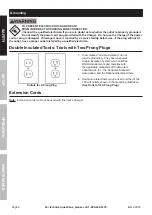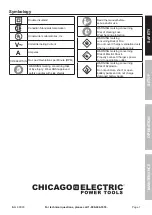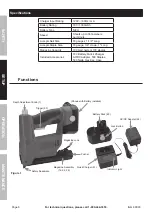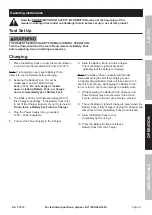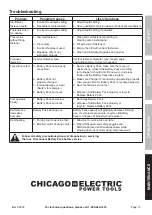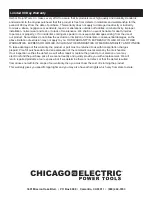
Page 3
For technical questions, please call 1-800-444-3353.
Item 68993
Sa
FE
ty
Op
ER
ati
O
n
m
aint
Enanc
E
SE
tup
personal safety
1.
Stay alert, watch what you are doing and use
common sense when operating a tool. Do not
use a tool while you are tired or under the
influence of drugs, alcohol or medication.
A moment of inattention while operating tools
may result in serious personal injury.
2.
use personal protective equipment. always wear
eye protection.
Safety
equipment used for
appropriate conditions will reduce personal injuries.
3.
Wear hearing protection when using the
tool.
Prolonged exposure to high intensity
noise is able to cause hearing loss.
4.
always assume that the tool contains fasteners.
Do not point the tool toward yourself or anyone
whether it contains fasteners or not.
5.
WaRninG – Do not fire fastener on top of another
fastener.
This is able to cause the fastener to be
deflected and hit someone, or cause the tool to
react and result in a risk of injury to persons.
6.
WaRninG – Remove finger from the trigger when
not driving fasteners.
Never carry the
tool with
finger on trigger, the tool is able to fire a fastener.
7.
prevent unintentional starting. Ensure the trigger
is released before connecting the battery pack,
picking up or carrying the tool.
Carrying tools with your finger on the
switch or energizing tools that have
the switch on invites accidents.
8.
Do not overreach. Keep proper footing
and balance at all times. This enables better
control of the tool in unexpected situations.
9.
Dress properly. Do not wear loose clothing or
jewelry. Keep your hair, clothing and gloves
away from moving parts. Loose clothes, jewelry
or long hair can be caught in moving parts.
10.
Only use safety equipment that has been
approved by an appropriate standards agency.
Unapproved safety equipment may not provide
adequate protection. Eye protection must be
ANSI-approved and breathing protection
must be NIOSH-approved for the
specific hazards in the work area.
tool use and care
1.
Use clamps or another practical way to secure
and support the workpiece to a stable platform.
Holding the work by hand or against the body
is unstable and can lead to loss of control.
2.
Do not force the tool. use the correct tool for
your application. The correct tool will do the job
better and safer at the rate for which it was designed.
3.
Do not use the tool if the trigger does not turn it
on and off.
Any tool that cannot be controlled with
the Trigger is dangerous and must be repaired.
4.
Disconnect the battery pack from the tool before
making any adjustments, changing accessories,
or storing tools.
Such preventive safety measures
reduce the risk of starting the tool accidentally.
5.
Store the tool out of the reach of children and
do not allow persons unfamiliar with the tool
or these instructions to operate the tool. Tools
are dangerous in the hands of untrained users.
6.
maintain the tool with care. check for
misalignment or binding of moving parts,
breakage of parts and any other condition that
may affect the tool’s operation. if damaged,
have the tool repaired before use. Many
accidents are caused by poorly maintained tools.
7.
use only accessories that are identified by the
manufacturer for the specific tool model.
Use of
an accessory not intended for use with the specific
tool model, increases the risk of injury to persons.
8.
use only those fasteners listed in the
Specifications chart of this manual.
Fasteners
not identified for use with this tool by the
tool manufacturer are able to result in a risk of injury
to persons or tool damage when used in this tool.






